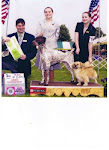Finding Motivation
The first thing we need to consider when beginning house-training is MOTIVATION. If you can answer the question for your pup of “why should I?” then you are well on your way.
So... why SHOULD your pup eliminate outside vs. inside? Because something VERY GOOD and desirable happens 100% of the time when they eliminate in the right place, that’s why. And it’s up to you to provide that very good thing immediately after your pup eliminates outdoors.
You can figure out quite quickly what that very good thing is by testing out a few tidbits of delicious rewards at the outset of your relationship with him/her. Whichever food reward is most highly regarded by your pup is the one to set aside as THE potty reward. You will give this reward ONLY for pottying and you will give it 100% of the time IMMEDIATELY after your pup potties outside.
Your brilliant pup will very quickly pair that reward with the desired behavior - i.e. “When I pee/poop outside, I get chicken! I love chicken!” And this, my dear friends, is how we create motivation in a new pup so that they begin to ASK for the door when they get the urge to eliminate.
Creating a Routine
Routine is everything to new pups and they very quickly begin to understand the house rules and routines. Get into a routine at the beginning of ownership so that your pup can begin to anticipate what to expect.
Escort your pup to the same corner of the yard every time you take them out and use a code phrase to encourage elimination, such as “do your business” or “get busy”. At first, your pup won’t know what you are saying but with enough repetition, they will quickly catch on.
The scent on the ground in the potty area may also stimulate the desire to eliminate, ensuring that your pup “gets busy” more quickly. For those with a fenced-in yard, you can remove your pup’s leash AFTER they potty (and get their food reward) as a further reinforcement/reward for eliminating outside. Freedom to roam is a privilege reserved for AFTER successfully eliminating.
Still Having Issues?
If your pup is continuing to have accidents inside the house, there are a few things to consider.
Are you taking them out frequently enough? If your pup is having an accident 45 minutes after you’ve taken them out, then perhaps you need to take them out every 30 minutes for a few days and then begin to stretch out the length of time between potty sessions.
Is your pup drinking a lot of water? Noticing when and how much your pup drinks (and eats) is helpful in figuring out when to offer potty breaks. If something goes IN, then it’s likely something will need to be eliminated very soon!
What if your pup doesn’t go when offered an outdoor potty break?
If you feel your pup should have eliminated but hasn’t, then s/he isn’t given any freedom when you go back inside the house. This is a good time for a brief period in the crate, perhaps with a bone to gnaw or a rubber toy stuffed with peanut butter. Take the pup back outside in 20 minutes to try again, and increase freedom inside the home only if the pup has an empty bladder or has pooped successfully.
Setting Up Your Puppy's Crate for House Training
You can also set your crate up for house-training success by following a few simple rules during the first month or two in your home.
- First, the crate should only be large enough for your pup to walk in, turn around and lie down. Any extra space beyond that only provides a place for elimination without your pup having to lie in it.
- Secondly, the crate should not have any sort of pad, bed or liner in it for the first several weeks. Anything that can absorb urine will be counter to your house-training. So remove the blanket, towel or bed that you have been lining the crate with....for now.

No comments:
Post a Comment